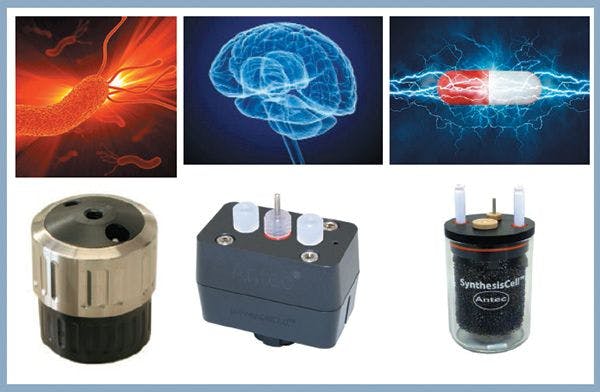Analysis of Phthalates in Polyvinyl Chloride (PVC) by Thermal Desorption GC–MS: Determination of Thermal Desorption Temperature Zone by Evolved Gas Analysis (EGA)
Special Issues
Phthalates are widely used as plasticizers in different industries to enhance product durability. It has been determined that many of the phthalates have a detrimental effect on human health. Six phthalates (shown in Table I) are now regulated by the EU (Directive 2005/84/EC) and the US (Consumer Product Safety Improvement Act, Section 108).

Table I: Use restricted phthalates (1% upper limit by directive 2005/84/EC
All the past methodologies for the determination of these phthalates are based on solvent extraction, filtration, and concentration. These traditional techniques are cumbersome, time consuming, and suffer from analyst-to-analyst variability while producing data of limited value.
In response to these analytical challenges and in conjunction with the ASTM, Frontier Laboratories developed a technique using the Multi-Shot Pyrolyzer coupled with a GC–MS system for analyzing phthalates in PVC. This technique provides scientists with a "method map" for identifying phthalates both qualitatively and quantitatively. First, Evolved Gas Analysis (EGA)-MS is used to determine the optimal thermal zone in which the target compounds evolve as the sample is heated. Then, a simple, one-step thermal desorption (TD)-GC–MS technique is used for the analysis. This application note details the first step of the "method map" for identifying the thermal desorption temperature zones of phthalates in PVC.
A sample consisted of small pieces of a PVC toy was taken from 10 different locations. They were dissolved in 1 mL of THF (50 mg/mL). Six different phthalates were added to the THF solution. 10 µL of the THF spiked solution was added to a sample cup; the solvent was evaporated leaving a thin film of the sample on the surface of the cup (ca. 0.5 mg).

Figure 1: TIC thermogram and extracted mass chromatograms of PVC, to which 1% of each phthalate was added
Figure 1 shows the obtained EGA thermogram and extracted ion chromatograms (EICs) that are used to determine the thermal zone for each of the phthalates and the hydrogen chloride that is generated as PVC is heated. Using average mass spectrum, the first peak is identified as DINCH (1,2 cyclohexane dicarboxylic acid di-isononyl ester). It is critical to ensure that the ions used to monitor the six phthalates can be differentiated from ions produced by non-target additives, like DINCH. The EICs clearly show that the temperature range in which all six phthalates are thermally desorbed is 100 to 350 °C.

This work clearly shows that the Frontier Multi-Shot Pyrolyzer is a viable technique in analyzing phthalates in many industries. Today, more laboratories are integrating the Frontier Multi-Shot Pyrolyzer into their mainstream analytical protocols due to the advantages and immediate quality improvements this technique provides. The Frontier Multi-Shot Pyrolyzer guarantees reproducibility and accuracy while all surfaces in the sample path are quartz deactivated using a proprietary process. There is NO transfer line and NO cross contamination. The system also increases laboratory productivity as sample preparation takes much less time than traditional techniques that require solvent extraction.

Quantum Analytics
Foster City, California, United States
tel. (650) 312-0900
Website: http://go.lqa.com/pyrolyzer-info















